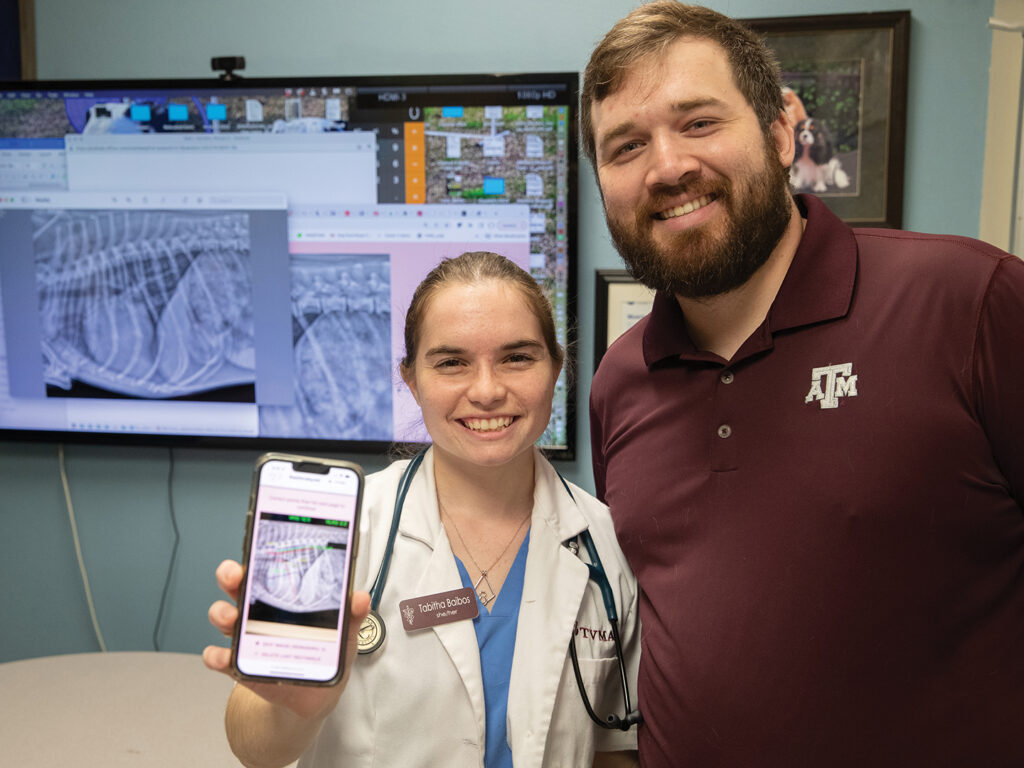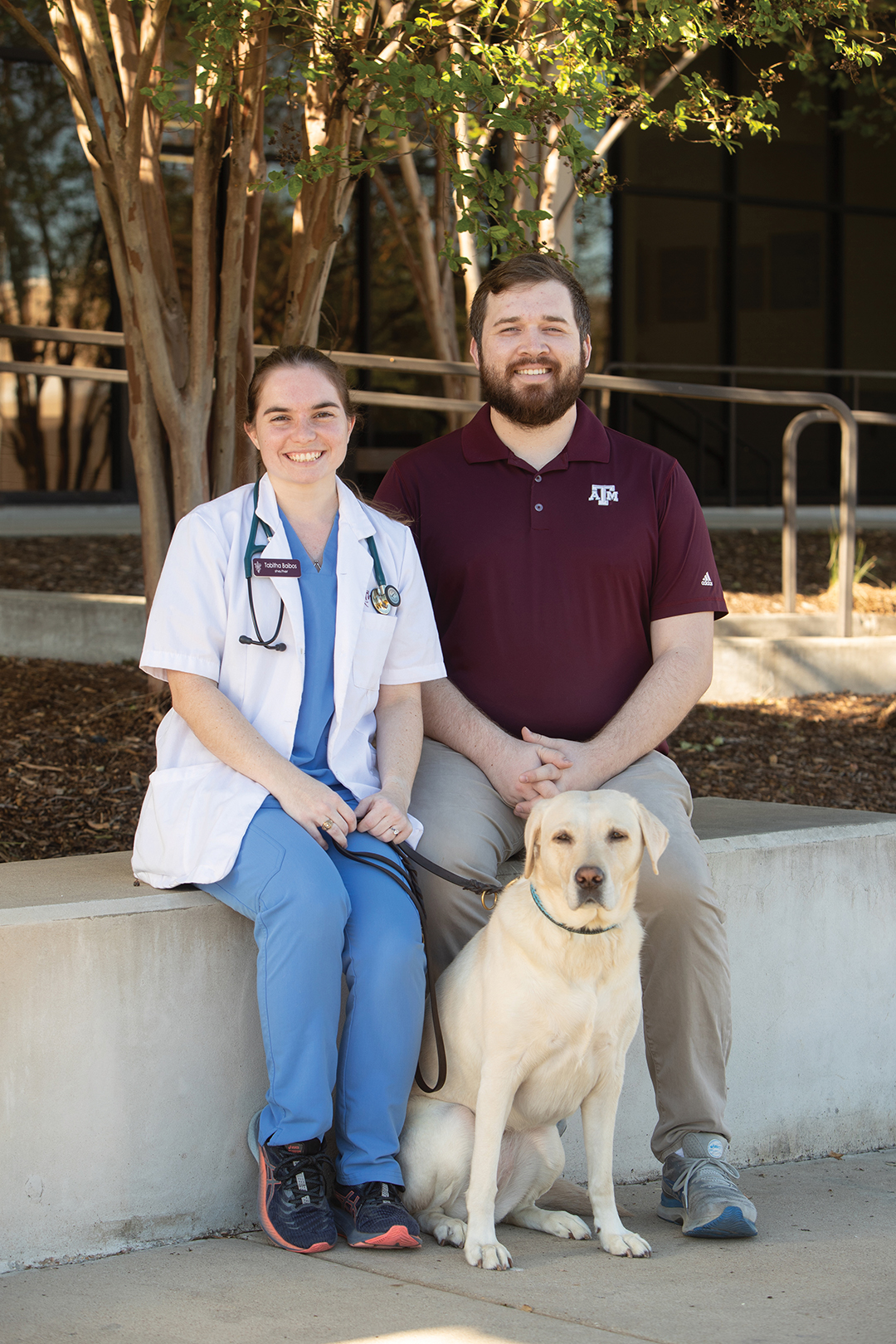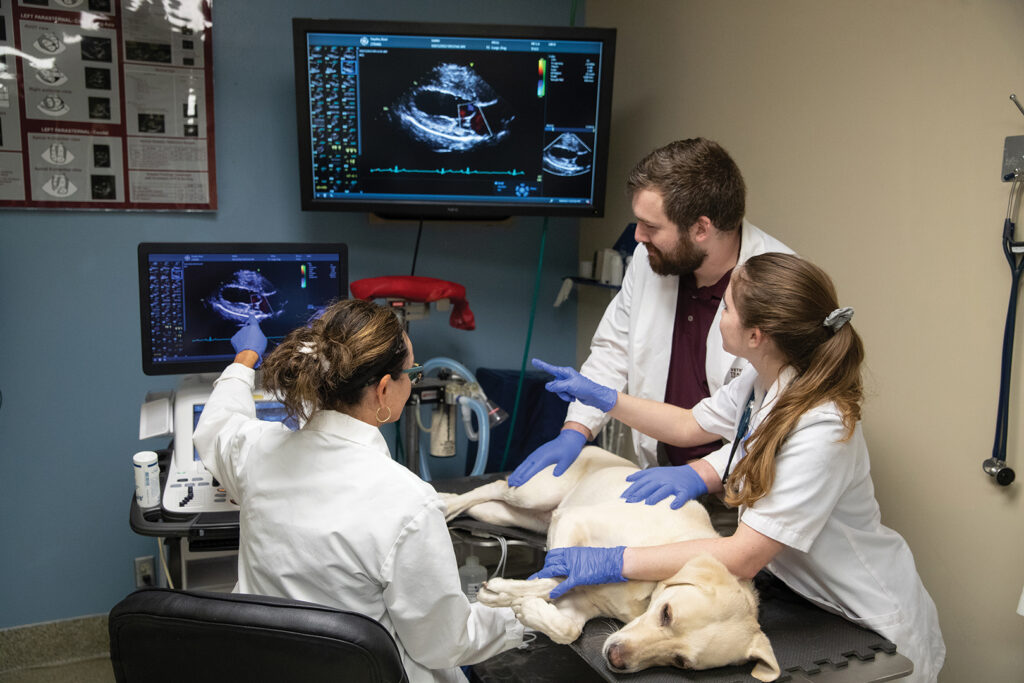Texas A&M Students Develop AI-Based Program To Help Diagnose Canine Heart Disease
Story by Ashley Vargo

Fourth-year veterinary student Tabitha Baibos and Tomas Reyes ’20, ‘22 (MS)
Artificial intelligence (AI) is a phrase on the tip of many tech experts’ tongues, and with the help of Texas A&M School of Veterinary Medicine & Biomedical Sciences (VMBS) fourth-year veterinary student Tabitha Baibos and her fiancé Tomas Reyes ’20 ‘22, AI is taking on new life in veterinary medicine.
After creating an award-winning prototype during a student competition, Baibos and Reyes are further developing their invention in an effort to improve canine heart disease treatment. Their AI-based algorithm has become the center of the pair’s start-up company and is now being fine-tuned with the help of VMBS professor and Eugene Ch’en Chair in Cardiology Dr. Sonya Gordon and other veterinarians.
Inception Of Radanalyzer
A desire to help animals is nothing new for Baibos; the pet parent of four cats and one dog has dreamed of becoming a veterinarian since she was young.
“I was introduced to the idea of becoming a veterinarian through a book series I read as a kid,” Baibos said. “I love to read, and there is a series called ‘Animal Ark’ about a little girl whose parents owned a veterinary clinic. I was in love with the series and read all of those books; that’s really what made me want to become a vet.”
Since becoming an Aggie veterinary student, Baibos has continually pursued opportunities beyond the school’s curriculum, including raising puppies for Guide Dogs for the Blind, as a VMBS student ambassador, and more.
This year, Baibos put her knowledge of veterinary medicine to the test through Aggies Invent, a 48-hour design competition in which students develop a prototype in response to a given challenge.
For the January 2022 VetMed competition, held in conjunction with the Texas A&M College of Engineering, the challenge was posed simply—create an innovative solution for a veterinary care problem.
Baibos was the sole veterinary student among a team of engineering students, which included her fiancé. Their team decided to tackle the prompt by developing a way to more easily calculate vertebral heart score in dogs — an area of much-needed development.
“When dogs start to develop heart disease — and this could be for several reasons, but it’s really common in smaller dogs as they get older — their hearts will start to get bigger, usually because there’s an increased amount of blood in the heart or it’s pumping really, really hard,” Baibos said. “Usually, a veterinarian has to stand at a computer and use a ruler tool on an X-ray image and hope they’re finding the right spots to measure from.”

While the typical method for measuring and calculating vertebral heart score is both time-consuming and error-prone, it is also vital because it helps veterinarians determine if treatment is necessary or if a certain course of treatment has been effective. Baibos and her team sought to take out the guess-work and the time constraints of the process.
“We went all over the web to find pictures of X-rays that we could use freely,” she said. “My fiancé made an algorithm using artificial intelligence that can literally just look at the picture and, within seconds, give you a calculation.”
Having someone with a veterinary background certainly gave Baibos’ team a competitive edge; it also gave Baibos the chance to take on a teaching role.
“It was a good challenge for me to be able to take my knowledge and explain it in a way that an 18-year-old with no veterinary background could understand,” Baibos said. “Some of my teammates never even had pets. So, having to explain these concepts, the whole veterinary side of things, was a challenge for me.
“The competition was super fun. I didn’t think I would enjoy it, but I loved it,” Baibos said. “It showed me that I am capable of doing more than I thought and gave me the opportunity to think about problems from a different perspective.”
After taking home first prize, Baibos and Reyes couldn’t simply abandon the work they’d done. Instead, they developed it further by co-founding RadAnalyzer, a company that aims to incorporate AI into everyday veterinary practice.
“After we finished the weekend project, we thought more about how there’s a need for this,” Baibos said. “We have spent the past couple of months working on it, and now we’re an official business.”
The duo has landed some minor investors already, and they aren’t stopping there.
“We just submitted our application for a start-up accelerator through Amazon Web Services,” Baibos said. “We’re also in the process of getting veterinarians to sign up and use our website.”
Improving The Algorithm
Vertebral heart score is traditionally measured by manually choosing specific points on a radiograph to mark the top and bottom of the heart, as well as the edges of the heart’s widest area. Veterinarians then measure these dimensions and determine how many vertebrae the measurement corresponds to on the dog’s spine. In total, seven points have to be found on an image each time.
RadAnalyzer finds these points and makes the measurements and calculations automatically, but it is still in the testing stage. The AI improves when experts validate the accuracy of its measurements or apply corrections when it chooses faulty points on new X-ray images.
The service is currently free for veterinarians to use in their own practices and to provide feedback. Veterinarians can upload patients’ anonymized X-ray images to the app or website, which will automatically calculate the vertebral heart score. The points on the vertebrae that the algorithm selects will appear on the image, and, if veterinarians using the program don’t agree with the points, they can make adjustments that the AI will learn from.

The AI is also learning more and more as interns at the Texas A&M Small Animal Teaching Hospital make use of the tool for cases requiring a vertebral heart score; their work is verified by Gordon and then uploaded to the RadAnalyzer database to give the AI a broader range of correct examples.
“The goal is to publish our results showing that the algorithm is accurate and that the test metrics are good,” Baibos said. “We’re basically training our machine-learning model as if Dr. Gordon is doing them all herself. We’re hoping to provide a level of quality and accuracy that would be equal to a board-certified cardiologist.”
For Baibos and Reyes, working on RadAnalyzer goes beyond merely a professional endeavor; the two have had to adapt to each other’s working styles, and, ultimately, Baibos believes that developing RadAnalyzer has had a positive effect on their relationship.
“Working on RadAnalyzer really gives us something to bond over,” Baibos said. “We had two separate worlds and were able to bring them together. It’s also really helped him to connect with my friends from vet school. And we got engaged literally a week after we won Aggies Invent, so, you could say it’s been really good for us.”
As for Baibos’ future, she plans to work at a feline-only clinic — perhaps, one day, even open her own — and get board certified in feline medicine. And although vertebral heart score isn’t used as often in cats as it is in dogs, RadAnalyzer will continue to be a major part of Baibos’ career.
“Our goal is to be able to use RadAnalyzer for things other than just vertebral heart score, like looking at diseases in the lungs or looking for bone fractures,” Baibos said. “So, hopefully, I will be able to use it in my own practice.”
Ultimately, Baibos hopes that the negative aspects of analyzing radiographs—the uncertainty of the measurements, the time required to get accurate results, and the cost to pet owners—will all be made obsolete with the expansion of AI.
“AI is going to be the future of a lot of things; people use it more often than they think they do,” Baibos said. “It is going to be a big thing in veterinary medicine, because it’s going to allow us to provide services to clients at a cheaper cost and a lot faster. With the high caseloads veterinarians have, it’s going to be a really good tool for the future.”
###
Note: This story originally appeared in the Winter 2023 edition of VMBS Today.
For more information about the Texas A&M College of Veterinary Medicine & Biomedical Sciences, please visit our website at vetmed.tamu.edu or join us on Facebook, Instagram, and Twitter.
Contact Information: Jennifer Gauntt, Director of VMBS Communications, Texas A&M College of Veterinary Medicine & Biomedical Sciences; jgauntt@cvm.tamu.edu; 979-862-4216


